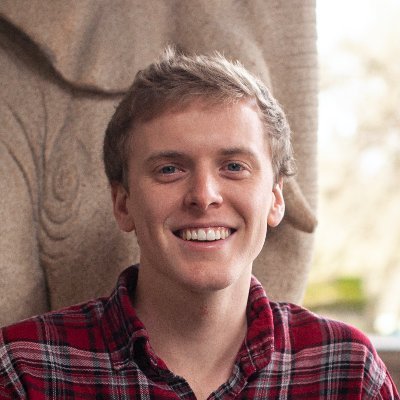
Nick LaBerge
@laberge_nick
Followers
122
Following
232
Media
10
Statuses
39
he/him 🏳️🌈 science of science research @ CU Boulder #BLM
Joined July 2020
1/ I’m excited to share our article "Gendered hiring and attrition on the path to parity for academic faculty" with @hneutr @aaronclauset @DanLarremore, now published @eLife : https://t.co/zt6yG18aBS What drives changes in gender diversity among faculty? Let’s go:🧵
1
14
36
13/ To sum up: - Hiring has had a greater impact on women's repr. (2011-2020) - Hiring is projected to be more impactful for future parity - Yet women are more likely to leave faculty jobs at every career stage, limiting trends to parity Details here:
elifesciences.org
Achieving gender parity among U.S. tenured and tenure-track faculty will require changes to hiring, which has substantially greater impacts on faculty gender representation than gendered differences...
0
0
1
12/ Another important limitation is that our study considers only faculty gender. Including other key variables like race and socioeconomic status will likely be crucial for comprehensive understanding of hiring and attrition dynamics, and impacts.
1
0
0
11/ One important limitation is that this work treats all attritions equally. Ex: retirements are treated the same as pulls to industry. But reasons for leaving have been shown to correlate with gender (pushes vs. pulls, see work by @thekatiespoon, https://t.co/OrTnT91FNt)
1/ New paper! “Gender and retention patterns among U.S. faculty” w/ @laberge_nick @hneutr @_szhang @alliecmorgan M Galesic @baileyfosdick @danlarremore @aaronclauset: https://t.co/u0zYHs4Sh2 A systematic study of gendered rates & reasons for faculty attrition in US academia 🧵
1
0
2
10/ Expanding projections across academic domains we find: 🚀 Substantial changes to hiring are needed to boost repr. in most fields 👴🏻 Waiting for retirement-driven turnover won't fix gender disparity 🏁 Many fields won’t reach parity if gendered differences in attrition persist
1
0
0
9/ In the Natural Sciences, we project that hiring more women would boost overall representation of women the most, while addressing attrition disparities in isolation would lead to smaller increases in representation.
1
0
0
8/ We model faculty hiring and attrition by setting attrition risks (gendered or neutral) and the fraction of women among hires (maintained or increased). Here's an example of projections for the Natural Sciences from 2020 onward for 5 scenarios:
1
0
0
7/ How much will the gender representation gap shrink in the next 40 years: - when the older generations of faculty retire? - if gendered differences in attrition are eliminated? - or if more women are hired as faculty?
1
0
0
6/ In other words, all-cause attrition is a mixed bag: Early and mid-career attrition differences cause a disproportionate loss of women faculty, even as late-career retirements of disproportionately men cause women’s representation to increase overall.
1
0
1
5/ All-cause attrition combines: (i) pre-retirement attrition and (ii) retirements. We show that pre-retirement attrition is gendered–women are more likely to leave faculty jobs than men at every career stage. Yet all-cause attrition increases women's repr. due to retirements.
1
0
0
4/ Analyzing faculty records (N=1,768,118 person-years) across 111 fields, 2011-2020, we find: 🔍 Hiring increased women’s representation in 95% of fields 🔍 Attrition (including retirements) increased women’s repr. in 74% of fields 🚀Hiring was the main driver in 87% of fields
1
0
0
3/ Faculty gender diversity changes via 2 processes: hiring & attrition. How important has each process been? The answer matters—interventions differ!—yet can't be learned from representation stats alone. Here, we use high-res data to separate & quantify the 2 effects over 10 yrs
1
0
0
2/ Even though women 🎓 have received more than 50% of BAs since 1981 and 👩🎓 earned 46% of U.S. PhDs in 2021 (🔬38% in STEM, 📚59% in non-STEM) 👩🏫 women comprise _only 36%_ of tenure-track faculty
1
0
0
"Subfield Prestige and Gender Inequality among U.S. Computing Faculty," by @laberge_nick et al., looks at how subfield structure and #prestige affect faculty #hiring for #diversity in #computing
https://t.co/UP8NUWu2H6. LeBerge discusses the work in video https://t.co/1d5F7b9N3f
0
3
9
12/ Also, I was interviewed about this project in a video by @CACMmag ! Check it out 📹:
0
2
6
11/ To sum up: we quantify the unequal way prestige intersects with subfields to constrain field-level gender diversity trends among US computing faculty, which can inform better efforts to make computing more diverse, equitable, and inclusive 📈
1
0
6
10/ Here’s a puzzle: to 📈 gender diversity, should you target hiring in more gender diverse subfields, eg, HCI, or target the less diverse subfields, eg, Theory? The answer probably requires a causal understanding of gender differences across subfields.
1
0
4
9/ Study limitations • Our subfield taxonomy and classifier are imperfect • We only consider tenure-track faculty • The racial group analysis has a small sample size (n=547) • Analyses are descriptive not causal • Many questions about mechanisms remain
1
0
4
8/ Notable patterns in that figure 🔍: in the transition from PhD to faculty, • Asian representation further increases • Black & Hispanic representation remains low • White representation decreases* *Hypothesis: because White PhDs disproportionately flow to industry?
1
0
4



